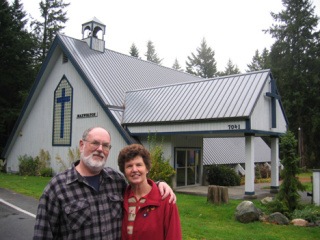The Little Brown Church is back in the family, and before long it will be back to the right color, too.
“When it becomes painting season, it will be brown again,” said George Mills, who with his wife, Lila, recently purchased the church in the Maxwelton Valley. The iconic church was built in 1910 by the congregation’s founders, among them Mills’ grandfather and great-grandfather.
“We’ve already had several people offer to bring over their paint brushes,” added Lila Mills.
“He always talked about the Little Brown Church,” she said of her husband. “I didn’t know it was so near and dear to him. My head’s still spinning.”
The church, currently gray, is at the intersection of Maxwelton Road and French Road, about a half-mile from Maxwelton Beach.
“It started Free Methodist and it ended Free Methodist,” said Mills, 61, a retired teacher who as a boy spent summers in the Maxwelton Valley, staying with his numerous relatives.
“It feels good to be back, though there aren’t as many relatives around as there used to be,” he said.
“I used to be related to almost everybody,” Mills added. “The Maxwelton Fourth of July Parade used to be all my family.”
The church congregation was established by a group of Maxwelton Valley residents in 1908, and in 1909 the members incorporated as the Whidbey Island Free Methodist Church.
George Mills’ grandparents, George and Sarah Grubb, were among the five members of the first official board. The first pastor was Frank DeLong.
In 1910, more than 80 people contributed a total of $884, and the original church and parsonage were built on land donated by John and Lorena Brixner.
They were simple structures resembling the buildings seen in Western movie sets. The original church was 32 feet by 70 feet, and featured, among other things, a pot-bellied stove, George Mills said.
The buildings were painted brown, and before long it became known as the Little Brown Church. The church stayed brown until 1993, when for some reason it was painted gray, George Mills said.
Even before the church was finished, the first funeral conducted in it was for Mills’ great-grandfather, John W. Grubb.
His grandfather, George Grubb, died in 1952, “and he kept a journal until the day he died,” Mills said.
George Mills said the Grubb family had moved from Kansas to what would later become the Rainier Valley neighborhood of Seattle, and from there to the Maxwelton Valley.
“They became Free Methodists in Kansas,” Mills said. “They moved out here to Washington, I’m not really sure why, and then to Whidbey Island, I’m not really sure why. But they brought the Free Methodist Church with them.”
The Free Methodist Church was founded in New York in 1860 by a defrocked minister of the Methodist Episcopal Church who had criticized the spiritual laxness of the church hierarchy. They were called Free Methodists because, among other things, they believed it was improper to charge for better seats in pews closer to the pulpit.
Free Methodists opposed slavery, and supported the equality of women in leadership positions. They also advocated “freedom” from “secret” societies such as the Freemasons.
“I was raised a Free Methodist,” George Mills said, “but I’ve been a Baptist since 1978.”
Mills said his mother, Dorothy Grubb, married John Mills, and they moved from the valley.
George Mills taught high school for 31 years in Toledo and Napavine in southwestern Washington. He retired when he and his wife moved to Bremerton to care for Lila’s mother.
Mills said his interest in his family was rekindled about a year and a half ago when a grandson of a relative contacted him for information about mutual kin.
“That got me started in genealogy,” he said, “and I’ve been a genealogist ever since.”
The church has quite a history, too. In 1934, a bell was purchased for $10 from a local school district and attached to the church roof.
“It’s still there, and it still works,” Lila Mills said.
In 1953, the old parsonage on the south side of the church was replaced by a new one to the north.
The current single-story parsonage, which the Mills are updating to use as their residence, was built in 1966.
In 1967, an extensive remodeling effort began on the church, turning it into it’s current A-frame configuration and adding additional rooms on each side.
The original colored glass windows where encased by the new roof, but skylights were added to let light through. Unfortunately, the skylights leaked, and had to be removed, George Mills said, but some electric lights were added to shine on the colored glass.
“Fortunately, the church building is in good shape,” George Mills said.
The Little Brown Church ended as a going concern in 2006 — “A difference of philosophy,” Mills said — and the property was put up for sale in 2007.
“We came to take a look at it,” Lila Mills said, “and we said this could change our lives.”
They made an offer, and it was accepted in August of this year.
The Mills said their plans for the church aren’t solidified. “We’re open to whatever comes down the line,” George Mills said.
He said he envisions it as a community gathering place for such things as retreats, weddings, funerals and public meetings.
“We don’t know yet what we can and can’t do,” he said. “We may have it registered as a historic building.”
Meanwhile, the reader board in front of the church contains the family’s request for more information about the building’s history and heritage.
“We want everybody to know about it,” Lila Mills said.
Anyone with information about the church can contact the couple at 579-2007.



